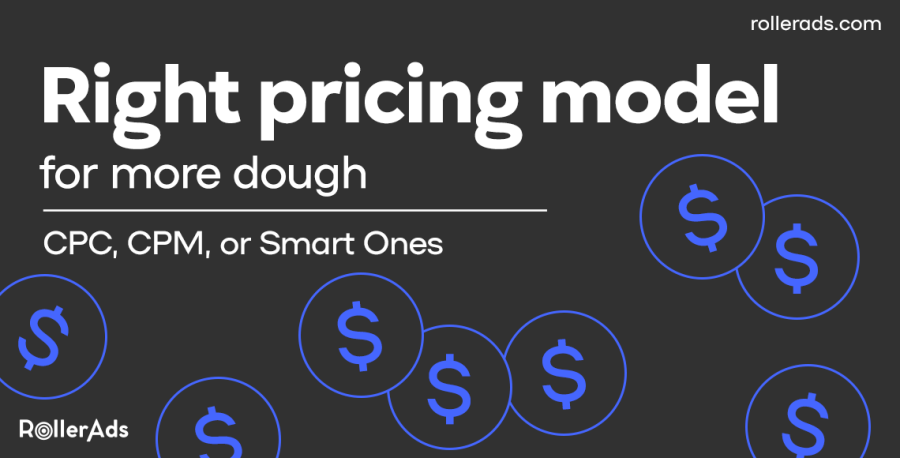Whenever promoting an offer, you have to pay for the spots the publisher provides you with. The question is, which paying model to choose? Worry not, this article cover exactly that. Brace yourself and let’s roll.
When an advertiser buys some ad spots from a publisher, they usually settle for one of the following advertising models:
- CPC: Cost-per-Click (Pay-per-Click)
- CPM: Cost-per-Mille (Cost-per-Thousand)
Cost per Click
CPC = each user’s click on your ad withdraws a fixed bid of money from your campaign budget. CPC is commonly used for push ads. Also, such websites as Google or Facebook prefer to use the CPC pricing model. To calculate CPC, you have to use the formula:
Cost per Click = Ad cost / Number of clicks
Assume you are selling shaving accessories for $20.
You have $200 for a budget.
Publisher charges you with $0.1 per click.
You are able to generate $200 / $0.1 = 2,000 clicks.
Out of 2,000 clickers, you have 50 buyers.
Your revenue is 50 x $20 = $1,000.
While your income equals $1,000 – $200 = $800.
CPC model has a serious flaw of useless clicking. Some users may be impatient and click twice, trice, or more. Furthermore, your competitors may eat through your clicks deliberately. Without limiting the number of clicks one user can make, you are risking spending all your ad budget for nothing. As a rule of a thumb, go for 2 clicks per user.
Cost per Mille
CPM = every 1,000 of impressions on an ad platform is to be paid. On-click (pop-under) is an ad format that is usually sold through the CPM model. In relation to the sales funnel, this model is one step longer than CPC, where the user is already acquainted with the product and clicks voluntary. Therefore, a colossal number of impressions will be lost along the funnel. Here is how to calculate CPM:
Cost per Mille = Ad cost / Number of impressions x 1,000
Suppose you are still selling the shaving accessories for $20.
You bought some CPM traffic for $200.
Publisher asks for $2 per 1,000 impressions.
That means $200 / $21,000 = 100,000 people would see your ad.
Now, if you divide the number of clicks from the CPC example by the number of impressions from CPM, you will get another crucial metric – Click-Through Rate (CTR):
Click Through Rate = 2,000 / 100,000 = 2%
The higher your CTR, the more lucrative the CPM model becomes. If your previous campaigns yielded 3% CTR, then with the same 100,000 number of impressions, you get additional 1,000 clicks for the same price of $200.
Therefore, CTR is more predictable and less risky, making it a viable choice when you do not have enough data on your previous campaigns (being new to affiliate marketing, trying out new niches, dealing with volatile demand etc.). CPM on the other hand allows making more bang for your buck if you are an experienced marketer and have some compelling creatives.
It can also save you from useless clicking, because one impression is reserved for just one user, no matter how many times they visit a website. Unless, of course, they modify their digital fingerprint (new device, VPN), which is more of an issue when it comes to the competitors, trying to drain your budget, which is still not an easy task.
Work Smarter, Not Harder
The preposition “Smart” is about using the artificial intelligence algorithms to protect yourself from overspending. Unlike CPC and CPM that require you to pay a fixed bid, both SmartCPC and SmartCPM allow the price to be changed on the fly, within the boundaries of the allocated budget. In other words, instead of always paying the top bid, you are enabled to pay less for the same number of clicks or impressions.
Smart-models are game-changers because they have some undeniable advantages:
- Saving cost on less expensive GEOs
- Trying out more expensive GEOs as a result
- Improving Return-on-Investment of the existing campaigns
- Enabling previously ROI negative campaigns to be profitable
Some sources, however, might be among your favorites, and you may want to take the manual control over them. That’s not an issue with the custom bidding option, which allows you to make an exception for smart or casual bidding. For instance, you can set a CPC bid of $0.08 for all the sources, except your favorite one, which can be higher, say $2.
Conclusion
Choosing between Cost-per-Click and Cost-per-Mille pricing models require you to understand your Click-Through Rate. If you are confident in your creatives and can provide high number of clicks constantly, then CPM helps to get free click for the same amount of money. Contrary, if the user hesitates to click, then CPM can be the cause of your campaign downfall.
While CPM sits at the top of the sales funnel, it can protect your budget from accidental (users) or intentional (rivals) double clicks. Therefore, CPM is the choice of experienced affiliates.
SmartCPC and SmartCPM are generally a direct upgrade to casual CPC and CPM, because it allows saving on costs. However, sometimes you may want to have more control over your bids. For these cases, you can use either traditional CPC and CPM or use the custom bidding option.





